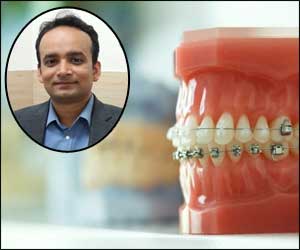- Home
- Editorial
- News
- Practice Guidelines
- Anesthesiology Guidelines
- Cancer Guidelines
- Cardiac Sciences Guidelines
- Critical Care Guidelines
- Dentistry Guidelines
- Dermatology Guidelines
- Diabetes and Endo Guidelines
- Diagnostics Guidelines
- ENT Guidelines
- Featured Practice Guidelines
- Gastroenterology Guidelines
- Geriatrics Guidelines
- Medicine Guidelines
- Nephrology Guidelines
- Neurosciences Guidelines
- Obs and Gynae Guidelines
- Ophthalmology Guidelines
- Orthopaedics Guidelines
- Paediatrics Guidelines
- Psychiatry Guidelines
- Pulmonology Guidelines
- Radiology Guidelines
- Surgery Guidelines
- Urology Guidelines
Why do some Teeth get pushed out of their Homes!

Romans are known for their beautiful nose & Greeks are known for the Greek-Godlike-jawline. The prominent jawline of Greeks indicates strong personality and vibrancy in character. So, while Angelina Jolie has a strong jawline, which makes her face appear slimmer and more chiseled; Selena Gomez has a weak jawline that makes her face look smaller, yet sweet & vulnerable.
Nutritional Periodontist, Dr Alvin H Danenberg while highlighting the fact that how eating habits define jawline says that hunter-gatherers who do not eat processed foods have strong jaws and healthy bodies. When some individuals from these groups migrated to different “modern” societies and replaced their traditional diets with highly processed “western diets”, things began to change. “These individuals over time developed chronic diseases and dental problems, and they had offspring with increased dental abnormalities,” he wrote.
Those who have well-defined jawline mean the bones are properly developed and it is good for your teeth - in other words, your jaw will be big enough to accommodate all teeth. A poorly developed jaw bone or a shrunken jaw bone, on the other hand, is home to many dental problems like crooked teeth and deep bite that also increase the risk of tooth decay and gum disease and ultimately ruins your dental health.
Thanks to Orthodontia, a specialized field in dentistry, and advances in technologies, there is hope for many with such problems. Orthodontia or Dentofacial Orthopaedics is that specialization of dentistry that corrects teeth and jaw alignment problems using braces and plates.
“What makes this specialty, a highly specialized one is the fact, that the tooth movement in the jawbone can be accomplished by application of very mild and highly controlled forces in 3 dimensions. These forces can be transferred to the teeth to be moved with the help of braces and wires involving very complex mechanics utilizing the Jawbone as an anchor. Wires are highly specialized with memory and hooks and tags are used for localizing the forces for better results"; says Lt Gen Dr Vimal Arora, Chief Clinical Officer at Clove Dental, India’s largest dental chain.
Dr Arora strongly advocates that parents must ensure that children are made to eat raw and fibrous food that stimulates and helps their muscle to exercise. Our ancestors ate raw and nutrient-dense foods that required them to chew more. Over a period of time, our habits changed. Most of us, especially, children and youth, prefer processed or soft edibles like baked goods, pasta, junk food and items made up of refined sugars which don’t require much chewing.
The tooth size in an individual is determined by hereditary meaning thereby that how big or small your teeth are likely to be will be determined by the parents through genetics.
However, the jaw size takes its shape due to the environmental factors like habits of chewing, speech & other masticatory functions. Everyone can make a definitive impact on how jaw will develop in kids by giving the right food and the right exercise. Let us take the first step towards that and make sure our kids have a strong jawline and they have awesome looks and have regular and strong teeth.
Dr Anirudh Singh is an Orthodontist at Clove Dental.

Disclaimer: This site is primarily intended for healthcare professionals. Any content/information on this website does not replace the advice of medical and/or health professionals and should not be construed as medical/diagnostic advice/endorsement or prescription. Use of this site is subject to our terms of use, privacy policy, advertisement policy. © 2020 Minerva Medical Treatment Pvt Ltd